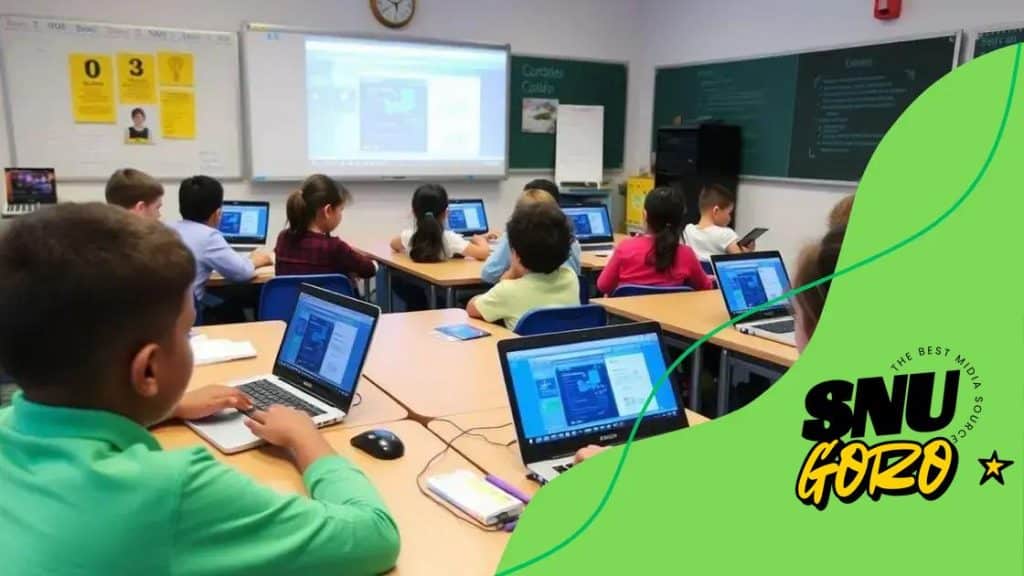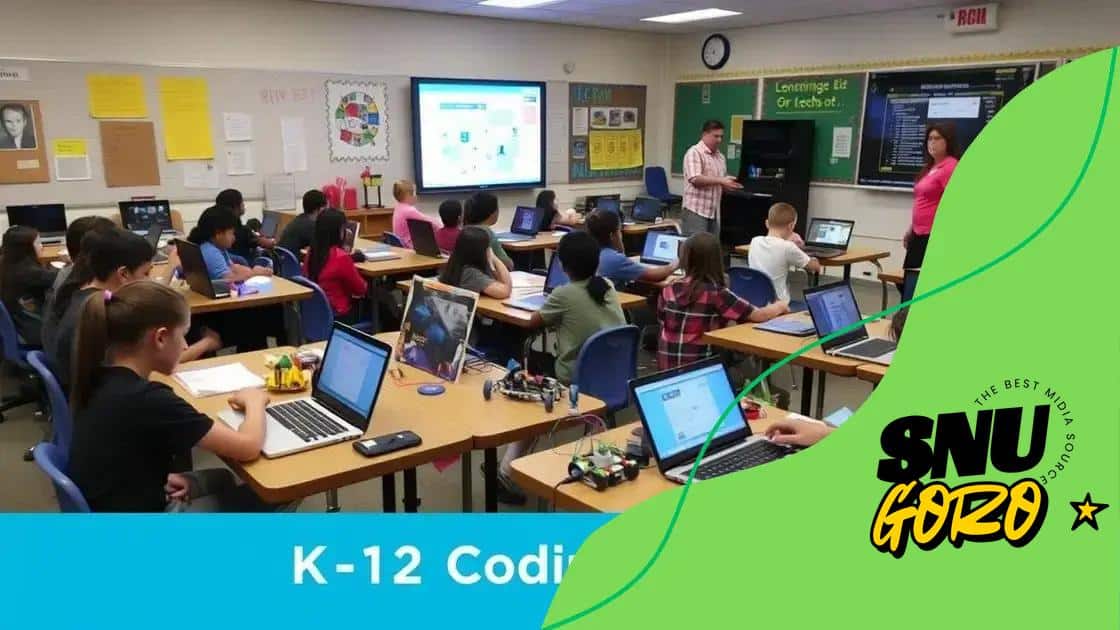Integrating coding into K-12 curricula: a game changer

Integrating coding into K-12 curricula enhances student engagement and critical thinking skills while preparing them for future job opportunities through hands-on projects and relevant, measurable learning outcomes.
Integrating coding into K-12 curricula can fundamentally transform education. But have you considered how these skills could shape your child’s future? Let’s explore this exciting opportunity together.
The importance of coding skills in today’s job market
Coding skills are becoming increasingly vital in today’s job market. With technology evolving at a rapid pace, employers are actively seeking individuals who are proficient in coding. These skills not only enhance employability but also open doors to various career paths.
Why Coding Skills Matter
Many industries are now leveraging technology, making it essential for workers to possess a basic understanding of coding.
- Increased job opportunities in tech-related fields.
- Ability to innovate solutions within organizations.
- Flexibility to pursue various career paths, including software development and data analysis.
- Understanding of digital tools that enhance productivity.
Moreover, coding fosters problem-solving skills. When students learn to code, they learn to think critically and approach challenges systematically. This mindset is beneficial, not only in tech roles but in any job scenario.
Growing Demand in Various Fields
Today, many sectors like healthcare, finance, and education have embraced coding as a crucial skill. For instance, data analytics has transformed how businesses operate, and understanding coding allows employees to contribute meaningfully.
Understanding coding empowers individuals to engage with technology innovatively. This engagement not only supports their current career but prepares them for future changes in the job market. It helps professionals stay relevant, as job roles are constantly evolving due to technological advancements.
How to incorporate coding into existing subjects
Integrating coding into existing subjects can enrich the learning experience for students. By merging these skills with traditional subjects, educators provide a more engaging curriculum. This helps students see how coding applies to real-world problems.
Utilizing Project-Based Learning
One effective method to incorporate coding is through project-based learning. Students can work on projects that intersect various subjects, like math and science.
- Create simple games that teach math concepts.
- Use coding to simulate scientific experiments.
- Develop apps that solve community issues.
This method fosters creativity and critical thinking, making learning more enjoyable.
Integrating with Language Arts
In language arts, coding can also play a significant role. Students can write interactive stories or create digital presentations. This not only improves their writing skills but also enhances their technical knowledge.
Working on these projects keeps students actively engaged, linking literature with technology. They learn to express their ideas creatively while becoming proficient in coding.
Regardless of the subject, finding connections with coding will deepen students’ understanding. Teachers can encourage students to explore how programming relates to history, art, and even music. By doing so, they cultivate a multidisciplinary approach to education.
Tools and resources for K-12 coding education

Having the right tools and resources is essential for effective coding education in K-12 settings. There are many platforms and materials available that make learning coding fun and engaging for students.
Online Platforms
Online platforms like Scratch and Code.org provide interactive ways for students to learn coding fundamentals. These sites offer tutorials and projects that cater to various skill levels.
- Scratch: A block-based visual programming language great for beginners.
- Code.org: Offers a range of coding courses and activities for all ages.
- Khan Academy: Provides computer programming courses that are self-paced and engaging.
These resources enable teachers to include coding in their classes without requiring extensive technical knowledge.
Physical Resources
In addition to online platforms, various physical resources enhance hands-on learning. Robotics kits such as LEGO Mindstorms or Ozobot are popular tools that teach coding through building and programming physical devices.
Using robotics in the classroom encourages collaboration among students and helps develop problem-solving skills. The combination of coding and robotics creates a stimulating environment for students.
Another valuable resource is teaching guides and curriculum frameworks that offer structured lessons on coding concepts. Many educational publishers provide these materials, making it easier for teachers to integrate coding into their subjects.
Engaging students with hands-on coding projects
Engaging students with hands-on coding projects makes learning interactive and enjoyable. By incorporating practical experiences, students can see the immediate impact of their coding skills.
Project Ideas
One great approach is to have students create their own video games. Platforms like Scratch allow users to design games from scratch, promoting creativity and problem-solving skills.
- Create simple games that reinforce math concepts.
- Develop storytelling projects where coding brings narratives to life.
- Work on collaborative projects that foster teamwork and communication.
Students can also engage in robotics projects, where they build and program robots to perform specific tasks. This not only enhances their coding skills but also improves critical thinking as they troubleshoot and optimize their designs.
Real-World Applications
Linking coding projects to real-world scenarios can further enhance engagement. For example, students can work on a project that addresses local community issues. This might involve developing an app to help organize community events or a website that promotes local businesses.
Such projects enable students to apply their coding skills in meaningful ways, showing them how technology can solve real problems. As they work through these projects, they develop a deeper understanding of both coding and the subject matter.
It’s important for teachers to facilitate these hands-on experiences by providing the necessary resources and guidance. Encouraging students to share their projects with peers can also boost motivation and inspire others to join in.
Measuring the impact of coding integration on learning
Measuring the impact of coding integration on learning is crucial for educators. Understanding how these skills influence student performance can help improve teaching methods and curricula.
Assessment Methods
One reliable way to assess the impact is through standardized tests. By comparing test scores before and after coding integration, teachers can see how much students have progressed.
- Evaluate student projects that highlight coding skills.
- Use surveys to gather feedback from students on their learning experience.
- Analyze the connection between coding skills and problem-solving abilities in different subjects.
Observations in the classroom can also be valuable. Teachers can note engagement levels and collaboration among students during coding activities. Increased interest often leads to better understanding and retention.
Data Analysis
Collecting quantitative and qualitative data is essential for a comprehensive analysis. This includes tracking the number of students participating in coding activities and their performance in related subjects.
Teachers can also implement formative assessments to gauge student understanding at various stages of the learning process. This ongoing evaluation helps identify areas where students may struggle, allowing for timely interventions.
Additionally, studying long-term outcomes can provide insights. For example, following students as they progress through grades can reveal patterns in academic success correlated with coding education. Schools can use this information to support their coding programs and justify their effectiveness.
Integrating coding into K-12 curricula can significantly enhance students’ learning experiences. It encourages critical thinking and problem-solving skills, which are essential in today’s technological world. By using hands-on projects, students become more engaged and motivated. Furthermore, measuring the impact of coding helps educators refine their teaching approaches and ensure that students are gaining valuable skills. Ultimately, the inclusion of coding prepares students for future challenges and opportunities in their careers.
FAQ – Frequently Asked Questions about Integrating Coding into K-12 Curricula
What are the benefits of integrating coding into K-12 education?
Integrating coding enhances critical thinking, problem-solving skills, and student engagement, preparing them for future careers.
How can teachers measure the impact of coding on learning?
Teachers can measure impact through standardized tests, project assessments, and classroom observations to track student progress.
What tools are recommended for coding education in schools?
Popular tools include Scratch for games, Code.org for interactive lessons, and robotics kits like LEGO Mindstorms for hands-on learning.
How can parents support their children’s coding education?
Parents can encourage coding at home through online resources, coding games, and participation in coding clubs or workshops.





